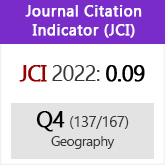European Immigrations
DOI:
https://doi.org/10.3989/estgeogr.201214Keywords:
international migrations of population, demography and gender in migrations, labor market, labor integration of immigrants, migration policies, migrations in Europe, Spain, a country of immigrationAbstract
In an interval of only six decades 1950-2010, we have witnessed the five centuries old emigration process interruption that has shaped modern European history. At the end of World War II begins an intense opposite migration flow from former European colonies to their historic metropolis, which had also incorporated other areas that never had that relationship of dependency. This phenomenon is undoubtedly the most important contemporary social process that has taken place in Europe. Such a transformation could only occur by the confluence of important complementary factors. In separate sections of this article we present the main causes of recent immigrations in Europe and what flows within Europe and from other continents can be identified. Second, we explore the key aspects of immigration: demographics, gender and labor market. Then, we study the problems of integration in the host societies and immigration policies that facilitate it. We ended our discussion with references to the singular case of Spain.
Downloads
References
Aja, E.; Arango, J. y Oliver, J. (dir.) (2010): "La inmigración en tiempos de crisis", en CIBOD (ed.): Anuario de la inmigración en España 2009. Barcelona, CIDOB.
Banco de España (2008): "Capítulo 2. El impacto de la crisis financiera sobre la economía española", en Banco de España (ed.): INFORME ANUAL 2008. Madrid, Banco de España, pp. 47-70. Disponible en: http://www.bde.es/f/webbde/SES/Secciones/Publicaciones/PublicacionesAnuales/InformesAnuales/08/inf2008.pdf (Fecha de consulta: 15/01/2012).
Barrett, A.; Mc Guinness, S. and O'Brien, M. (2008): "The Immigrant Earnings Disadvantage across the Earnings and Skills Distributions: The Case of Immigrants from the EU's New Member States in Ireland". Discussion Paper Series, 3479, Institute for the Study of Labor. Disponible en: http://ftp.iza.org/dp3479.pdf (Fecha de consulta: 16/01/2012).
Castles, S. and Davidson, A. (2000): Citizenship and Migration: Globalization and the politics of belonging. New York, Palgrave, 258 pp.
Castles, S. (2009): "Migration and the Global Financial Crisis: A Virtual Symposium. Update 1.A: An Overview". Disponible en: http://www.age-of-migration.com/uk/financialcrisis/updates/1a.pdf (Fecha de consulta: 17/01/2012).
Cebrián, J. A.; Bodega, M. I. y Martín Lou, M. A. (2008a): "La inversión migratoria en Europa". ARBOR Ciencia, Pensamiento y Cultura, CLXXXIV/734, pp. 1129-1146.
Cebrián, J. A. y Vázquez, A. (2008b): "Demanda general de trabajo e inmigración laboral", en Fundación Ciudadanía y Valores (ed.): Actas del Simposio Internacional "Inmigración y Desarrollo: Las Remesas". Madrid, Fundación Ciudadanía y Valores. Disponible en: http://www.funciva.org/documentos/index/categoria/social/ano/2008 (Fecha de consulta: 16/01/2012).
Chiswick, B. R. (2001): "The Economics of Illegal Migration for the Host Economy", en Siddique, M.A.B. (ed.): International Migration into the 21st Century. Cheltenham, UK, Edward Elgar, pp. 74-85.
Coleman, D. A. (2002): "Replacement migration, or why everyone is going to have to live in Korea: a fable for our times from the United Nations". Phil. Trans. R. Soc. Lond, 357, pp. 583–598. http://dx.doi.org/10.1098/rstb.2001.1034 PMid:12028794 PMCid:1692968
Coleman, D. A. (2003): "Mass Migration and Population Change". Zeitschrift für Bevölkerungswissenschaft. Verlag für Sozialwissenschaften, Jg. 28, 2-4/2003, pp. 719–751.
Dobson, J.; Latham, A. and Salt, J. (2009): "On the Move, Labor Migration in Times of Recession". Policy Network Papers, July 2009. Disponible en: http://www.policynetwork.net/uploadedFiles/Publications/Publications/On%20the%20move%20%20Labour%20migration%20in%20times%20of%20recession.pdf (Fecha de consulta: 16/01/2012).
EUROSTAT (2005): Annual report. EUROSTAT.
EUROSTAT (2006a): "Long-term population projections at national level". Statistics in focus. Population and Social Conditions, 3/2006.
EUROSTAT (2006b): "Non-national populations in the EU Member States". Statistics in focus. Population and Social Conditions, 8/2006.
EUROSTAT (2007): Annual report. EUROSTAT.
EUROSTAT (2009a): "Citizens of European countries account for the majority of the foreign population in EU-27 in 2008". Statistics in focus. Population and Social Conditions, 94/2009.
EUROSTAT (2009b): "Foreign citizens made up 6% of the EU population", EUROSTAT Newsrelease, 184/2009.
EUROSTAT (2010): "Foreigners living in the EU are diverse and largely younger than the nationals of the EU Member States". Statistics in focus. Population and Social Conditions, 45/2010.
EUROSTAT (2011): EUROSTAT Database/Population: Population by sex, age group and citizenship, last update: 03-03-2011, oldest data: 1998, most recent data 2010. European Communities.
Favell, A. (2008): "The new face of East-West migration in Europe". Journal of Ethnic and Migration Studies, 34/5, pp. 701-716. http://dx.doi.org/10.1080/13691830802105947
Fernández Ordóñez, M. (2007): Immigration and the Inflation Moderation Debate, Madrid, Banco de España, 7 pp.
Fix, M.; Papademetriou, D. G.; Batalova, J.; Terrazas, A.; Yi-Ying Liu, S. and Mittlestadt, M. (2009): "Migration and the Global Recession". Migration Policy Institute, September 2009, 131 pp.
IOM (2000): Informe sobre las Migraciones en el Mundo en 2000. Publicaciones de la ONU, 310 p.
IOM (2003): Informe sobre las Migraciones en el Mundo en 2003. Publicaciones de la ONU, 396 p.
Krings, T.; Bobek, A.; Moriarty, E.; Salamo ska, J. and Wickham, J. (2009): "New Times? Economic Crisis, geo-political transformation and the emergent migration order defying the recession? Polish migrants in Post-Celtic Tiger Ireland". Centre on Migration, Policy and Society, University of Oxford, 15 pp.
López-Sala, A. and Ferrero-Turrión, R. (2011): "Migration and the Economic Crisis: Implications for Policy in the European Union", en Fundación Ciudadanía y Valores (ed.): Simposio Internacional de Inmigración, Inmigración y Globalización. Madrid, Fundación Ciudadanía y Valores, 14 pp.
Martin, P. (2005): "Economic Costs and Benefits of International Labor Migration", in IOM (ed.): World Migration Report. Geneva, IOM, pp. 185-197.
Martin, P. (2009): "The Recession and Migration: Alternative Scenarios". Oxford, International Migration Institute, Working Papers, 13.
Martin, P.; Abella, M. and Kuptsch, C. (2006): Managing Labour Migration in the Twenty-First Century. New Haven/London, Yale University Press.
Mattila, H. S. (2001): "Protection of Migrants' Human Rights: Principles and Practice", in IOM (ed.): The Human Rights of Migrants. Geneva, IOM and ONU, pp.53-72.
Naïr, S. (2006): Y vendrán… Las migraciones en tiempos hostiles. Barcelona, Bronce, 312 pp.
OECD (2004): Trends in International Migration. SOPEMI 2003 edition, ISBN 92-64-01944-8.
OECD (2005): Trends in International Migration. SOPEMI 2004 edition, ISBN 92-64-007942-X.
OECD (2009): International Migration Outlook 2009. Paris, Organisation for Economic Co-Operation and Development.
Oliver Alonso, J. (2006): "Inmigración y mercado del trabajo en 2006: Razones de la acentuación del choque inmigratorio", en CIDOB (ed.): Anuario la inmigración en España 2006. Barcelona, CIDOB.
Papademetriou, D. G.; Sumption, M. and Somerville, W. (2009): "Migration and the Economic Downturn: What to expect in the European Union". Migration Policy Institute, 19 p.
Rinken, S. (2005): "La situación laboral de los inmigrantes: ¿una nueva paradoja de la satisfacción?". Panorama Social, 2/segundo semestre, pp. 112-128.
Rogers, A.; Anderson, B. and Clarke, N. (2009): Recession, Vulnerable Workers and Immigration: Background Report. Oxford, Centre on Migration, Policy and Society.
Saczuk, K. (2003): "A development and critique of the concept of replacement migration". Oxford, Central European Forum For Migration Research, Working Paper 4/2003, 22 pp.
Salt, J. (2001): "The Business of International Migration", in M. A. B. Siddique (ed.): International Migration into the 21st Century. Cheltenham, UK, Edward Elgar, pp. 86-108.
Smith, J. P. and Edmonston, B. (1997): The New Americans: Economic, Demographic and Fiscal Effects of Immigration. Washington DC, National Academy Press.
United Nations (2000): Replacement Migration: Is it a Solution to Declining and Ageing Populations?. New York, ESA/P/WP.160.
Downloads
Published
How to Cite
Issue
Section
License
Copyright (c) 2012 Consejo Superior de Investigaciones Científicas (CSIC)

This work is licensed under a Creative Commons Attribution 4.0 International License.
© CSIC. Manuscripts published in both the printed and online versions of this Journal are the property of Consejo Superior de Investigaciones Científicas, and quoting this source is a requirement for any partial or full reproduction.All contents of this electronic edition, except where otherwise noted, are distributed under a “Creative Commons Attribution 4.0 International” (CC BY 4.0) License. You may read here the basic information and the legal text of the license. The indication of the CC BY 4.0 License must be expressly stated in this way when necessary.
Self-archiving in repositories, personal webpages or similar, of any version other than the published by the Editor, is not allowed.
















